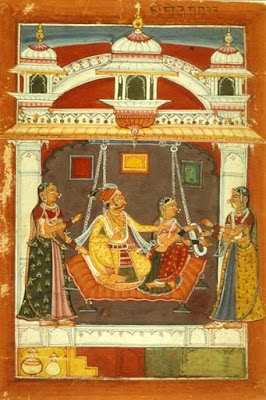Dear Sri Sandeep Bagchee,
Recently I have purchased a copy of your excellent book "Nad - Understanding Raga Music". I wish to thank you for the many hours of enjoyment which reading this book has given me. The printing and production of the book is also a pleasure to the eyes and hands.
However, emboldened by your request for feedback to make the book still better (Preface Page 13), I am listing out a few points which have drawn my attention.
1. In page 210, in the discussion on the construction of the sitar, it is stated "This arrangement (of 24 frets) is called 'Achal That' while the other arrangement of 16 or 20 frets is referred to as the 'Chal That'. The former arrangement was preferred by sitar players such as Ustad Mushtaq Husain Khan of Senia Gharana and Pandit Debabrata Chaudhuri, his student". This statement gives rise to the impression that Pandit Debabrata Chaudhuri uses a sitar with 24 frets (Achal That), whereas in fact he uses a sitar with only 17 frets (Chal That) removing the frets for madhya sthayi komal gandhar and komal nishad.
None of the leading sitarists use a sitar with 24 frets. Only the late Pandit Balram Pathak used a sitar with frets for both madhyam sthayi komal and shuddha rishabh, but it did not have a fret for tara sthayi madhyam, making the total number of frets still 20. All the other leading sitarists use sitars with 19 or 20 frets, with only one fret each for madhya sthayi rishabh and dhaivat.
2. In page 211, para 3, it is stated that Ustad Vilayat Khan's style of tuning "keeps the overall register high" and in page 250, para 1, it is stated that stringing and tuning the sitar by Pandit Ravi Shankar "lead to a lower pitch for this instrument". However on a study of the recordings of these maestros, it is clear that both use a pitch of approximately C sharp.
3. In Page 211, last para, it is stated that "Male artists usually sit in a cross-legged fashion to play the sitar, while women sit with their legs to one side". However, it is observed that women also usually sit cross-legged ex. Smt. Jaya Biswas.
4. In Page 252, Para 2, a notable omission in the list of sarod players of Maihar Gharana is Smt. Sharan Rani.
Thanking you for your time and attention.
Yours sincerely,
R.Ramachandra.
Dear Sri. Ramachandra,
Thank you for your letter. I am grateful to you for the encouragement and appreciation that you have conveyed in your letter as well as for the feedback that you have given.
As regards the number of frets on the sitar, the tuning of the sitar and the sitting positions, I have taken note of the points and would make the necessary corrections. Thank you, once again, for your suggestions, and words of appreciation which are very encouraging.
With regards,
Yours sincerely,
Sandeep Bagchee.
Recently I have purchased a copy of your excellent book "Nad - Understanding Raga Music". I wish to thank you for the many hours of enjoyment which reading this book has given me. The printing and production of the book is also a pleasure to the eyes and hands.
However, emboldened by your request for feedback to make the book still better (Preface Page 13), I am listing out a few points which have drawn my attention.
1. In page 210, in the discussion on the construction of the sitar, it is stated "This arrangement (of 24 frets) is called 'Achal That' while the other arrangement of 16 or 20 frets is referred to as the 'Chal That'. The former arrangement was preferred by sitar players such as Ustad Mushtaq Husain Khan of Senia Gharana and Pandit Debabrata Chaudhuri, his student". This statement gives rise to the impression that Pandit Debabrata Chaudhuri uses a sitar with 24 frets (Achal That), whereas in fact he uses a sitar with only 17 frets (Chal That) removing the frets for madhya sthayi komal gandhar and komal nishad.
None of the leading sitarists use a sitar with 24 frets. Only the late Pandit Balram Pathak used a sitar with frets for both madhyam sthayi komal and shuddha rishabh, but it did not have a fret for tara sthayi madhyam, making the total number of frets still 20. All the other leading sitarists use sitars with 19 or 20 frets, with only one fret each for madhya sthayi rishabh and dhaivat.
2. In page 211, para 3, it is stated that Ustad Vilayat Khan's style of tuning "keeps the overall register high" and in page 250, para 1, it is stated that stringing and tuning the sitar by Pandit Ravi Shankar "lead to a lower pitch for this instrument". However on a study of the recordings of these maestros, it is clear that both use a pitch of approximately C sharp.
3. In Page 211, last para, it is stated that "Male artists usually sit in a cross-legged fashion to play the sitar, while women sit with their legs to one side". However, it is observed that women also usually sit cross-legged ex. Smt. Jaya Biswas.
4. In Page 252, Para 2, a notable omission in the list of sarod players of Maihar Gharana is Smt. Sharan Rani.
Thanking you for your time and attention.
Yours sincerely,
R.Ramachandra.
Dear Sri. Ramachandra,
Thank you for your letter. I am grateful to you for the encouragement and appreciation that you have conveyed in your letter as well as for the feedback that you have given.
As regards the number of frets on the sitar, the tuning of the sitar and the sitting positions, I have taken note of the points and would make the necessary corrections. Thank you, once again, for your suggestions, and words of appreciation which are very encouraging.
With regards,
Yours sincerely,
Sandeep Bagchee.











